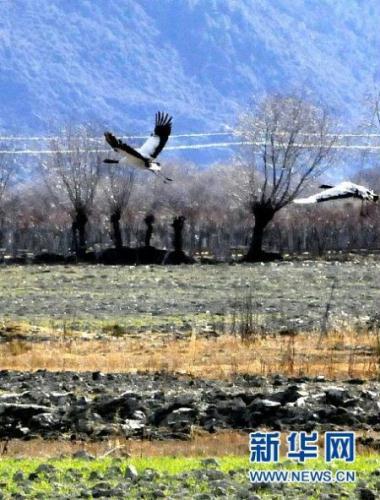| Videos | ? Latest |
|
? Feature | ? Sports | ? Your Videos |
Class one animal in Tibet: Black-necked crane

 0 Comment(s)
0 Comment(s) Print
Print E-mail
CNTV, July 15, 2011
E-mail
CNTV, July 15, 2011
Black-necked cranes are as famous as pandas and are a species of wildlife subject to first class State protection. They are found almost entirely in southwest China's Tibet Autonomous Region, where they make up 75 percent of the world's total. This rare species of bird is revered in Buddhist traditions and culturally protected across much of its range.
|
|
|
Black-necked cranes are as famous as pandas and are a species of wildlife subject to first class State protection. They are found almost entirely in southwest China's Tibet Autonomous Region, where they make up 75 percent of the world's total. |
This medium-sized crane is mostly grey with a black head and neck. The crown is bare and dull red. A small patch of white feathers is present below and behind the eye. Its black tail makes it easy to distinguish at a distance from the similar looking Common Crane which has a grey tail.
Living on a plateau at 5000 meters above sea level, black-necked cranes constitute the only crane species multiplying in the area. Generally, they nest in marshland, and by lakes and river shores. They live on roots and shoots of plants, and soft insects.
They fly across the Yunnan-Guizhou Plateau to the Qinghai-Tibet Plateau in March, and begin to multiply in late April, laying one to two eggs apiece, which hatch about a month later.
The Selingcuo nature reserve center is one of the optimal choices for this rare species to breed.
Tsamcho Doma, Expert of Black-Necked Crane Protection, said, "The reason black-necked cranes build their nests in the center of the lake is to avoid nature predators and other threats."
NUGA, an experienced worker at the Selingcuo Reserve, knows very well about the behavior of the crane. This pair of crane have built their nest in the centre of the lake. Nuga would come to see them everyday. He would be pleased to see the couple there living safe and sound.
Like many other crane species, they are believed to form long-lasting bonds and dancing displays are made during the breeding season.
Nuga, Staff of Selingcuo Nature Reserve, said, "My duty is to check their breeding, and see how are they getting along with people...The protection is going very well, this is true, I'm not saying it to praise my home town but this is the fact."
According to statistics released by the US International Cranes Foundation and the Tibet Plateau Biological Research Institute, the number of black-necked cranes has increased significantly over the past decade. The estimated population of Black-necked Crane is between 8,800 and 11,000. The birds are legally protected in China. However, habitat modification, drying of lakes and agricultural activities are threats to the bird population.






